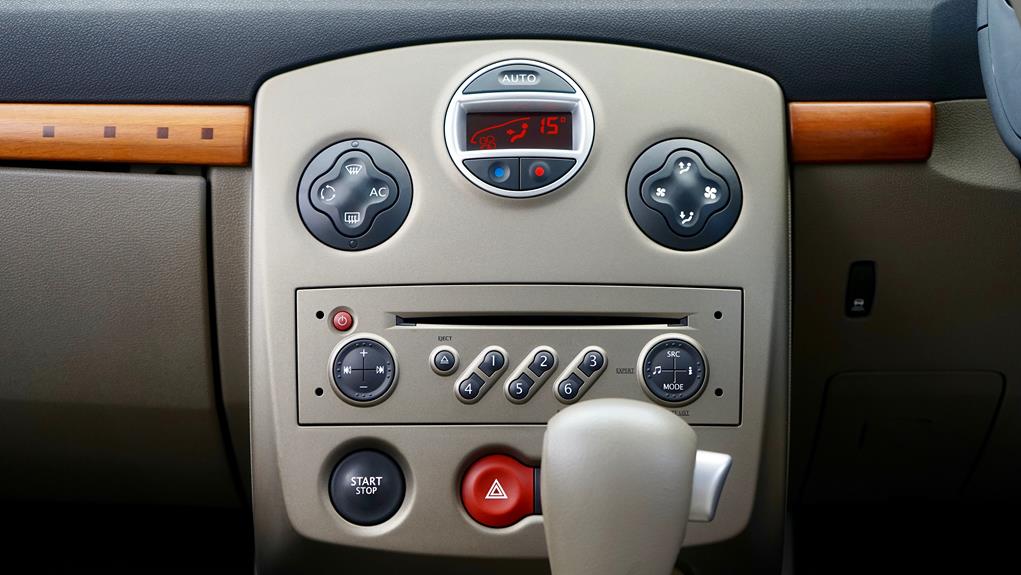Did you know that upgrading your car's audio system with the right amplifier can significantly enhance your driving experience? With the multitude of options available, selecting the perfect amplifier can be a daunting task. However, fear not! In this article, we will guide you through the technical aspects of amplifiers, helping you understand power ratings, impedance, types, installation, and troubleshooting. Get ready to unlock the full potential of your car's sound system and enjoy a liberating audio experience on the road.
Key Takeaways
- Choose the right type of amplifier for your car audio system, such as mono, stereo, or multi-channel, based on your specific needs and preferences.
- Consider the power ratings of amplifiers, including RMS power and peak power, and match them with the power handling capabilities of your speakers to avoid damage.
- Find a balance between power and sound quality by considering power requirements, vehicle size, proper installation, and reputable amplifier brands known for high-quality audio reproduction.
- Ensure proper impedance matching between the amplifier and speakers to avoid distortion and optimize performance, considering impedance measurements and the ability of high-quality amplifiers to adjust impedance settings.
Selecting the Right Amplifier for Your Car
Carefully selecting the right amplifier for your car is crucial in achieving optimal audio performance. A car audio amplifier is an electronic device that boosts the audio signal from the head unit and delivers it to the speakers. There are various amplifier types available in the market, including mono, stereo, and multi-channel amplifiers. Mono amplifiers are designed to power a single subwoofer, while stereo amplifiers provide separate channels for the left and right speakers. Multi-channel amplifiers offer even more flexibility, allowing you to power multiple speakers and subwoofers.
When selecting an amplifier, it's important to consider the power ratings. Amplifier power ratings indicate the maximum amount of power the amplifier can deliver to the speakers. The power rating is usually measured in watts and is specified for both the RMS (continuous) power and peak power. RMS power is the continuous power the amplifier can deliver without distortion, while peak power refers to the maximum power it can handle for short bursts. It's crucial to match the amplifier's power rating with the power handling capabilities of your speakers to avoid damaging them.
Understanding amplifier power ratings is essential for ensuring that you achieve the optimal audio performance in your car. By selecting an amplifier that provides adequate power to your speakers and subwoofers, you can enjoy enhanced sound quality and a more immersive audio experience.
Understanding Amplifier Power Ratings
When it comes to understanding amplifier power ratings, there are two key points to consider: power versus sound quality and matching speakers and amplifier. Power ratings determine the amount of electrical power an amplifier can deliver to the speakers, which in turn affects the overall sound quality. It is important to find the right balance between power and sound quality, as too much power can result in distortion, while too little power can lead to insufficient volume. Additionally, matching the power capabilities of the amplifier with the power handling capabilities of the speakers ensures optimal performance and prevents damage to either component.
Power Vs. Sound Quality
Determining the appropriate amplifier power rating is crucial for achieving optimal sound quality in your car audio system. When it comes to amplifiers, there is a delicate balance between power and sound quality. Here are four key factors to consider when evaluating power vs. sound quality:
- Power requirements: Consider the power needs of your speakers and the size of your vehicle. Ensure that the amplifier can provide enough power to drive your speakers effectively without distortion.
- Amplifier installation: Proper installation is essential for maximizing sound quality. Ensure that the amplifier is correctly wired and mounted in a suitable location to minimize interference and maximize performance.
- Amplifier brands: Different amplifier brands offer varying levels of sound quality. Research reputable brands known for their high-quality audio reproduction to ensure optimal sound performance.
- Amplifier sound quality: Look for amplifiers that offer features such as low distortion, high signal-to-noise ratio, and wide frequency response. These factors contribute to cleaner and more accurate sound reproduction.
Understanding the relationship between power and sound quality is essential when choosing the right amplifier for your car audio system. In the next section, we will discuss the importance of matching speakers and amplifier to further enhance your audio experience.
Matching Speakers and Amplifier
A crucial step in enhancing your car's audio system is ensuring a proper match between the speakers and amplifier, as well as understanding the amplifier power ratings. Matching the speakers and amplifier is essential to achieve optimal sound quality and prevent any damage to the speakers or amplifier. To aid in this process, it is important to understand the amplifier power ratings. Amplifier power ratings indicate the amount of power an amplifier can deliver to the speakers. It is crucial to match the power rating of the amplifier with the power handling capability of the speakers. Failure to do so can result in distorted sound, speaker damage, or even amplifier failure. To help you understand the power ratings better, here is a table that illustrates the relationship between amplifier power ratings and speaker power handling capabilities:
| Amplifier Power Rating | Speaker Power Handling Capability |
|---|---|
| 50W | 25W |
| 100W | 50W |
| 200W | 100W |
Matching Amplifier Power to Your Car's Speakers
Optimizing the power output of your amplifier to match your car's speakers is crucial for achieving the best audio performance. When it comes to car audio systems, finding the right balance between the amplifier's power output and the speakers' capabilities can make a significant difference in the overall sound quality and listening experience. Here are four important factors to consider when matching amplifier power to your car's speakers:
- Power handling: Ensure that the amplifier's power output is within the power handling range of your speakers. Exceeding this limit can damage the speakers, while underpowering them may result in poor sound quality.
- Impedance matching: Match the impedance rating of your speakers to the amplifier's output impedance. Mismatched impedance can cause distortion and affect the overall performance.
- Sensitivity rating: Consider the sensitivity rating of your speakers, which determines how loud they can play with a given amount of power. Matching the amplifier's power output to the speakers' sensitivity rating ensures optimal volume levels and prevents distortion.
- Speaker size and type: Different speakers have different power requirements based on their size and type. Larger speakers generally require more power, while certain types, such as subwoofers, may require dedicated amplifiers to drive them effectively.
The Importance of Impedance in Car Audio Systems
When it comes to car audio systems, impedance plays a crucial role in determining the overall sound quality. Impedance refers to the electrical resistance a speaker presents to the amplifier's output. Matching the impedance of your speakers to the amplifier ensures optimal power transfer and prevents distortion, resulting in cleaner and more accurate sound reproduction.
Impedance and Sound Quality
The impedance of a car audio system significantly influences the overall sound quality experienced by the listener. Impedance refers to the resistance that an audio component presents to the flow of electrical current. When it comes to car audio, the impedance of the speakers and the amplifier must be matched for optimal performance. Here are four reasons why impedance is crucial for sound quality in car audio systems:
- Distortion Reduction: Matching the impedance ensures that the amplifier and speakers work together efficiently, reducing distortion and maintaining clarity in the audio reproduction.
- Power Efficiency: Proper impedance matching allows the amplifier to deliver the right amount of power to the speakers, maximizing efficiency and preventing overheating.
- Frequency Response: Impedance affects the frequency response of the audio system. A mismatched impedance can result in uneven frequency response, leading to a loss of detail in certain frequency ranges.
- Speaker Protection: Ensuring the correct impedance match protects the speakers from damage caused by excessive power or voltage fluctuations.
Matching Speakers and Amplifier
With proper impedance matching, the speakers and amplifier in a car audio system can work harmoniously to deliver high-quality sound reproduction. Impedance refers to the measure of opposition to the flow of electrical current in a circuit, and it plays a crucial role in determining the efficiency and performance of a car audio system. Matching the impedance of the speakers to that of the amplifier ensures that the power is properly transferred from the amplifier to the speakers, preventing issues such as distortion, overheating, and even damage to the equipment. When the impedance is mismatched, the power transfer becomes inefficient, resulting in reduced sound quality and potentially damaging the components. It is essential to consult the manufacturer's specifications and guidelines to ensure proper impedance matching for optimal audio performance in your car audio system.
Types of Amplifiers for Car Audio
There are various amplifiers available in the market today that can greatly enhance the audio quality of your car. When choosing an amplifier for your car audio system, it's important to consider the specific needs and preferences of your vehicle. Here are four types of amplifiers that can help you achieve the best audio experience in your car:
- Mono Amplifiers: These amplifiers are designed to power subwoofers and are ideal for producing deep and powerful bass. They deliver a single channel of amplification, providing increased power to your subwoofer and enhancing low-frequency sound reproduction.
- Multi-Channel Amplifiers: These amplifiers are versatile and can power multiple speakers in your car audio system. They come in various configurations, such as 2-channel, 4-channel, and even 5-channel, allowing you to customize your setup based on the number of speakers you have.
- Class-D Amplifiers: Class-D amplifiers are known for their efficiency, making them a popular choice among car audio enthusiasts. They use digital switching technology to deliver power to your speakers, resulting in less heat generation and increased battery life.
- High-End Amplifiers: If you're looking for the ultimate audio experience, high-end amplifiers offer exceptional sound quality and advanced features. These amplifiers are designed with premium components and advanced circuitry to deliver superior performance and precise sound reproduction.
Installing an Amplifier in Your Car
Before you begin installing an amplifier in your car, it is important to gather all the necessary tools and materials. Installing an amplifier may seem like a daunting task, but with the right tools and a little patience, you can achieve professional results. To start, you will need an amplifier wiring kit, which typically includes power and ground cables, a remote turn-on wire, and RCA cables. Additionally, you will need a wire stripper, wire cutter, and crimping tool to properly connect the wires. It is also recommended to have a multimeter to ensure proper voltage and continuity during the installation process.
Once you have gathered all the required tools and materials, the next step is to locate a suitable installation spot for the amplifier. Choose a location that is secure and allows for proper ventilation to prevent overheating. It is also important to consider the length of the power and ground cables, as they should be as short as possible to minimize voltage drop.
After finding the ideal location, you will need to connect the power cable to the positive terminal of the car's battery. Make sure to use a fuse holder near the battery to protect the amplifier and the vehicle's electrical system in case of a short circuit. Run the power cable through the vehicle's firewall and connect it to the amplifier's power input terminal. Similarly, connect the ground cable to a clean, bare metal surface in the vehicle, preferably close to the amplifier.
Next, connect the remote turn-on wire to the amplifier's remote terminal. This wire will activate the amplifier when the car's audio system is turned on. To ensure proper audio signal transmission, connect the RCA cables from the car's head unit to the amplifier's RCA inputs.
Finally, it is crucial to double-check all connections and ensure that all wires are properly insulated to prevent any electrical shorts or interference. Secure all cables and wires using zip ties or wire loom to keep them neat and organized.
Adjusting Equalizer Settings for the Best Sound
To achieve optimal sound quality, it is essential to carefully adjust the equalizer settings in your car's audio system. The equalizer is a powerful tool that allows you to fine-tune the audio frequencies to suit your personal preferences. Here are four key factors to consider when adjusting the equalizer settings:
- Frequency Range: The equalizer typically has multiple frequency bands that can be adjusted. Experiment with different frequencies to find the sweet spot for each band. Boosting the bass frequencies can add depth and richness to your music, while attenuating the higher frequencies can reduce harshness.
- Q Factor: The Q factor controls the width of the frequency band being adjusted. A higher Q value narrows the band, allowing for precise adjustments, while a lower Q value widens the band, providing a more subtle effect. Finding the right balance between narrow and wide bands can significantly impact the overall sound quality.
- Balance: Adjusting the balance between the left and right channels can enhance the stereo imaging. It is crucial to ensure that the sound is evenly distributed between the speakers for an immersive listening experience.
- Pre-Set Options: Many car audio systems come with pre-set equalizer options such as Rock, Pop, or Jazz. While these presets can be a good starting point, they may not necessarily be tailored to your specific preferences. Experiment with these presets and make further adjustments to achieve the desired sound.
Troubleshooting Common Amplifier Issues
One of the most common amplifier issues that car owners may encounter is a loss of sound quality due to a faulty connection. When the connection between the amplifier and the audio source is compromised, it can result in distorted or weak sound output. To troubleshoot this issue, the first step is to check all the cables and connectors for any signs of damage or loose connections. Ensure that the cables are properly plugged in and securely fastened.
Another common issue is amplifier overheating. Amplifiers generate heat during operation, and if not properly ventilated, this can lead to overheating. To resolve this problem, ensure that the amplifier is installed in a well-ventilated area. Avoid placing it in enclosed spaces or near heat sources. It is also recommended to use a fan or install a cooling system to regulate the temperature of the amplifier.
In some cases, amplifiers may produce a humming or buzzing sound. This can be caused by a ground loop, which occurs when there are multiple ground connections in the audio system. To eliminate the hum, it is advisable to use a ground loop isolator or connect all the components to a common ground point.
Maximizing Sound Quality With Amplifier Accessories
Two popular amplifier accessories that can greatly enhance sound quality are a signal processor and a noise suppressor. These accessories work in conjunction with the amplifier to ensure that the audio produced is of the highest quality possible.
- Signal Processor: A signal processor is a device that manipulates the audio signal before it reaches the amplifier. It can adjust the equalization, balance, and other parameters to optimize the sound for your specific preferences. With a signal processor, you can fine-tune the audio to achieve the perfect balance between bass, midrange, and treble frequencies.
- Noise Suppressor: As the name suggests, a noise suppressor helps eliminate unwanted noise from the audio system. It reduces background noise, static, and interference, resulting in a cleaner and more enjoyable listening experience. By effectively suppressing noise, the music becomes more immersive and the details become more pronounced.
- Enhanced Clarity: With a signal processor and noise suppressor, you can enjoy enhanced clarity in your car's audio system. The signal processor allows for precise adjustments, ensuring that each instrument and vocal is heard with utmost clarity. The noise suppressor eliminates distractions and unwanted sounds, allowing you to focus on the music without any interruptions.
- Immersive Soundstage: By maximizing sound quality with these amplifier accessories, you can create a more immersive soundstage in your car. The signal processor and noise suppressor work together to optimize the audio, creating a wider and more spacious soundstage. This gives you a more realistic and enveloping listening experience, as if you were sitting in a concert hall.
Frequently Asked Questions
How Do I Choose the Right Amplifier for My Car's Audio System?
To choose the right amplifier for your car's audio system, consider factors such as power output, impedance compatibility, and features like built-in crossovers. Research different brands and models, and consult with experts for personalized recommendations.
What Are the Different Types of Amplifiers Available for Car Audio?
The different types of amplifiers available for car audio include mono amplifiers, 2-channel amplifiers, 4-channel amplifiers, and multi-channel amplifiers. Each type has its own benefits and is designed for specific audio setups and preferences.
What Are the Common Issues That Can Occur With Car Amplifiers and How Can They Be Resolved?
Common issues with car amplifiers include overheating, distortion, and electrical interference. To resolve these problems, ensure proper ventilation, check connections, and use quality cables. Consult a professional if issues persist.
Are There Any Specific Amplifier Accessories That Can Enhance the Sound Quality in My Car?
Yes, there are specific amplifier accessories that can enhance sound quality in your car. These include digital sound processors, equalizers, and signal converters, which optimize audio signals and provide a more immersive listening experience.
How Can I Adjust the Equalizer Settings on My Amplifier to Get the Best Sound in My Car?
To get the best sound in your car, adjust the equalizer settings on your amplifier by considering the desired audio output and the acoustic characteristics of your car. Experiment with different settings to find the optimal sound quality.
Conclusion
In conclusion, selecting the right amplifier for your car is crucial in enhancing your audio experience. Understanding power ratings, matching amplifier power to your car's speakers, considering impedance, and choosing the right type of amplifier are key factors to consider. Installing the amplifier correctly and adjusting equalizer settings can further optimize sound quality. Troubleshooting common amplifier issues and using amplifier accessories can maximize your car's audio potential. Just like a conductor leading an orchestra, the right amplifier can harmonize all the elements of your car's audio system, delivering a captivating performance.



